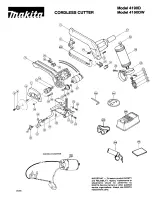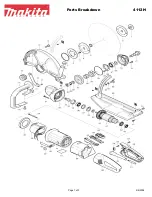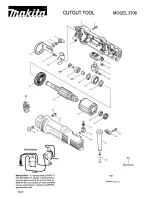
EN
42
916.400.096_003
PCU50
•
Short-circuit
•
Over temperature
3.10
Accessories Pentheon system
/i
4
Preparation for first use
4.1
General
•
Examine the equipment for completeness and damage. Do not use the equipment if it is damaged;
in that case contact the Holmatro dealer.
•
Examine the operation of the deadman's handle. when released, the deadman's handle must return
to the neutral position.
•
Before first use, charge the battery pack fully. Refer to section 5.2.
•
Put the battery pack in the battery pack fitting / adapter fitting until the battery pack locks.
•
Examine the battery pack to make sure that the lock mechanism operates correctly.
5
Operation
5.1
System operation
In a battery tool the hydraulic pump is integrated. An electric motor operates the hydraulic pump. The
electric motor is energized by a battery pack or from an external electric power source. This pump
displaces hydraulic oil and can build up pressure. The hydraulic pump is connected directly to the
hydraulic cylinder.
The hydraulic cylinder contains a plunger that can move axially. If the cylinder is filled with oil from the
bottom, the piston moves out. If the cylinder is filled from the top, the piston moves in. The direction in
which the piston moves is controlled by the so-called deadman's handle. The deadman's handle can be
rotated by the user to control the movement. If the deadman's handle is released, it returns
automatically to the neutral position and stops the movement of the tool.
In tools like cutters, spreaders and combi tools the movement of the piston drives a mechanism to make
a cutting or spreading movement.
Description
model
plug type
Battery pack
PBPA287
151.000.583
Battery charger
PBCH1
AC-EU
151.000.629
PBCH2
AC-US
151.000.742
PBCH3
DC worldwide
151.000.632
PBCH4
AC-JP
151.000.630
PBCH5
AC-UK
151.000.631
Mains connector
PMC1
EU
151.000.633
PMC2
US
151.000.743
PMC4
JP
151.000.634
PMC5
UK
151.000.635
On-tool charge cable
POTC1
worldwide
151.000.499
Daisy chain power cable
DCPC1
worldwide
151.000.503
Summary of Contents for PCU50
Page 3: ...PCU50 916 400 096_003 3 Fig 1 Fig 2 ...
Page 4: ...4 916 400 096_003 PCU50 Fig 3 Fig 4 Fig 5 ...
Page 173: ...PCU50 916 400 096_003 173 i Fig 6 Fig 7 ...
Page 174: ...174 916 400 096_003 PCU50 Fig 8 Fig 9 Fig 10 Fig 11 90 C A A B ...
















































